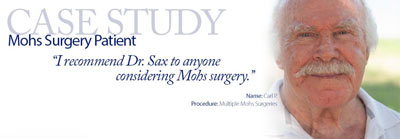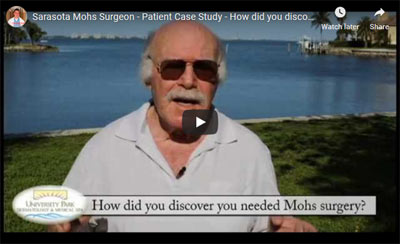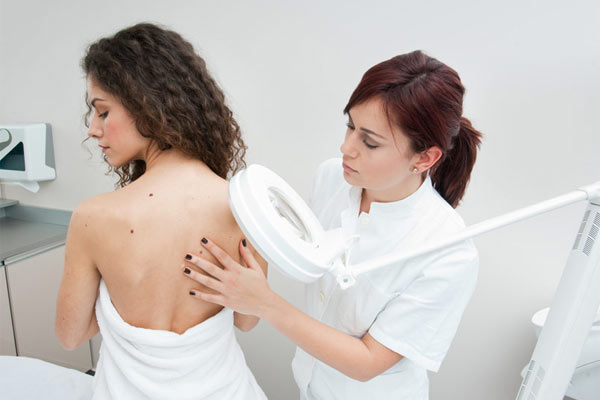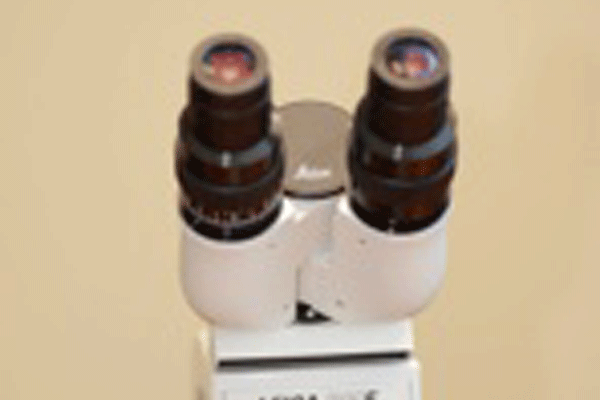- What to expect during Mohs surgery
- How it works
- Is the Mohs procedure painful?
- How long does the procedure take?
- How long does recovery take?
- Will the surgery leave a scar?
- Is Mohs right for me?
- Does someone need to drive me to and from the procedure?
- Who is a good candidate?
- What areas can be treated using Mohs surgery?
- Is Mohs surgery the best option?
- What to expect after Mohs surgery
Introducing Mohs micrographic surgery for skin cancer
Mohs micrographic surgery is the most advanced and effective treatment for skin cancer available today. Dr. Sax uses this innovative technique to:
- Ensure complete cancer removal and virtually eliminate the chance of the cancer returning
- Minimize scarring and the amount of healthy tissue lost
- Maximize functional and cosmetic results after surgery
- Remove the cancer and repair the surgical site on the same day (in most cases)
- Deliver a nearly 99% success rate, even for skin cancers that have been previously treated using another method
What to expect during Mohs surgery
The Mohs surgery technique is extremely effective in Dr. Sax’s expertly trained hands. He performs the procedure in his state-of-the-art office using local anesthesia, which targets the side effects of general anesthesia and promotes faster recovery time.
During the Mohs procedure, Dr. Sax removes skin cancer cells layer by layer and examines them under a microscope until healthy, cancer-free tissue around the tumor is reached. This technique allows him to remove the minimum amount of tissue needed, which is especially important for cancers near the eyes, nose, ears or lips, or on the hands.
Check out a complete
Mohs surgery Sarasota
video case study
Skin cancer is very common, with over 2 million people being diagnosed with it every year. In fact, it’s the most common form of cancer in the country. The good news is that skin cancer is very treatable and cure rates are high, provided is diagnosed and treated early.
Mohs surgery is a type of advanced microscopic surgery that’s used in the treatment of skin cancer. One of the most important things you should know about Mohs surgery is that the success rates using it are extremely high, at nearly 99%. This is one of the biggest benefits of the surgery.
How it works
Mohs surgery is typically performed under local anesthesia. This is beneficial since it eliminates the side effects that come with general anesthesia. The main way in which Mohs surgery differs from routine surgical excision is that the tissue removed is microscopically examined. This enables the surgeon to ensure that the tumor is completely removed before any skin is repaired.
With standard surgical excision, there is no opportunity to examine the removed tissue in nearly the same way. This means that residual tumor can easily be missed and would have to be removed with another surgical procedure. Mohs surgery allows for the smallest amount of skin possible to be removed, minimizing scarring significantly.
Is the Mohs procedure painful?
Before the procedure, Dr. Sax uses a local anesthetic to numb the surgery site, making the surgery itself virtually pain free. Depending on the location of the cancer there may be some discomfort in the first few days following surgery but severe pain is uncommon, and pain medication is only needed in rare cases.
How long does the procedure take?
Patients should expect to be in the office for 2-3 hours, however each procedure is unique. Certain factors such as the size and location of the tumor, and whether or not cosmetic repair is needed post surgery can affect the total procedure length.
How long does recovery take?
Most patients are able to return to their daily lives the day after surgery, though a bandage is often worn for the week following the procedure. The affected area must be cleaned and an antibiotic must be applied twice a day until the sutures are removed approximately a week after surgery. Strenuous activity, alcohol, and other blood thinners such as aspirin should be avoided in the 2 weeks following a Mohs procedure.
Will the surgery leave a scar?
All surgical procedures, including Mohs, have the potential to leave some scarring, but permanent scarring is generally not expected. The size and location of your tumor, as well as your individual skin characteristics all play a part in determining if scarring will be an issue. Thanks to the skilled hands of Dr. Sax the majority of our patients are scar free within months of the surgery.
Is Mohs right for me?
Only Dr. Sax will be able to determine the best course of action for your individual case. Mohs surgery is the preferred method for the removal of skin cancers around the face, ears, and hands due to its near 99% cure rate and the surgeon’s ability to completely remove the cancer while leaving the surrounding skin intact.
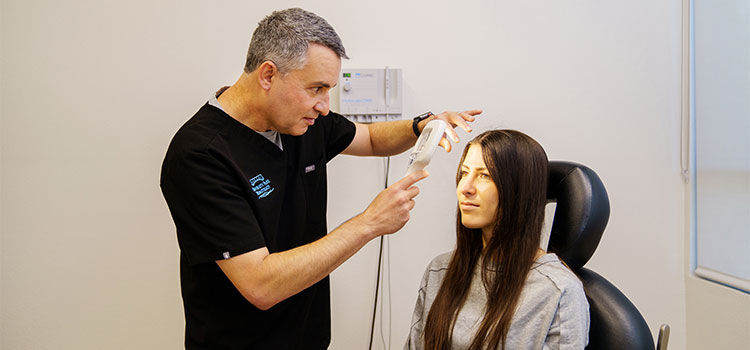
Does someone need to drive me to and from the procedure?
A local anesthetic is all that is needed for Mohs surgery, making it safe to drive home after your procedure. If your tumor is very near your eyes or nose the swelling that occurs post surgery may impair your vision, and a driver could be necessary.
Who is a good candidate?
Mohs surgery is available to anyone who has skin cancer, however there are certain things that make a good candidate. Firstly you should not have any overwhelming fear of surgical procedures. You should also be able to tolerate local anesthesia well.
What areas can be treated using Mohs surgery?
Mohs surgery is mostly used for treating head and neck skin cancers. One of the big benefits of it is that it can be used to treat difficult areas, such as the nose and ears. Mohs surgery can also be used on the hands and feet, and depending on the patient and form of caner they have – other areas of the body too.
Is Mohs surgery the best option?
Although it has an extremely high success rate, the answer to this question will vary from patient to patient. There are other forms of treatment available, such as radiation, plastic surgery and cryosurgery. Mohs surgery is often combined with other forms of treatment. For example, it may be used to remove the tumor and then plastic surgery is used to treat the area afterwards.
What to expect after Mohs surgery
After the Mohs procedure is complete, Dr. Sax may allow the area to heal on its own, or he may close the wound with simple stitches, a skin flap or a skin graft. He will carefully monitor your healing, and with Mohs surgery, you face only a 1-4% chance that cancer will return—the lowest rate of any skin cancer treatment option.
*Source: American College of Mohs Surgery website (www.skincancermohssurgery.org)
Take the first step to successful skin cancer treatment—call or request your appointment here.







